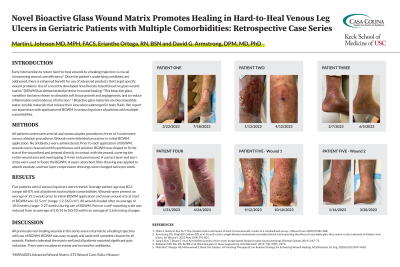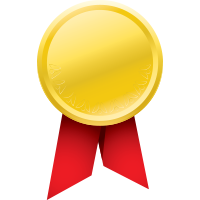Case Series/Study
(CS-078 (GR-003)) Novel Bioactive Glass Wound Matrix Promotes Healing and Decreases Pain in Hard-to-Heal Venous Leg Ulcers in Geriatric Patients with Multiple Comorbidities: Retrospective Case Series

Early intervention to return hard-to-heal wounds to a healing trajectory is crucial in improving wound care efficiency. Once the patient’s underlying conditions are addressed, there is enhanced benefit for use of advanced products that target specific wound problems. Use of a recently developed novel borate-based bioactive glass wound matrix* (BGWM) has demonstrated promise in wound healing. This bioactive glass nanofiber has been shown to stimulate soft tissue growth and angiogenesis, and to reduce inflammation and incidence of infection. Bioactive glass materials are biocompatible water-soluble materials that release their ions when submerged in body fluids. We report our experience with application of BGWM in venous leg ulcers of patients with multiple comorbidities.
Methods:
All patients underwent arterial and venous duplex procedures; three of 5 underwent venous ablation procedures. Wounds were debrided once prior to initial BGWM application. No antibiotics were administered. Prior to each application of BGWM, wounds were cleansed with hypochlorous acid solution. BGWM was shaped to fit the size of the wound bed and pressed directly in contact with the wound, covering the entire wound area and overlapping 3-4 mm onto periwound. A contact layer and steri-strips were used to fixate the BGWM. A super-absorbent fiber dressing was applied to absorb exudate, and two-layer compression dressings were changed twice per week.
Results:
Five patients with 6 venous leg ulcers were treated. Average patient age was 79 (range: 68-87) and all patients had multiple comorbidities. Wounds were present an average of 15.1 weeks prior to initial BGWM application and mean wound size at start of BGWM was 13.5 cm2 (range: 1.2-56.0 cm2). All wounds healed after an average of 10.0 weeks (range: 3-27 weeks) during use of BGWM. Pain on a self-reporting scale was reduced from 5.8/10 to 0.0/10 within an average of 2.6 dressing changes.
Discussion:
All previously non-healing wounds in this series were returned to a healing trajectory with use of BGWM. BGWM was easy to apply and used until complete closure for all wounds. Patients tolerated the matrix well and all patients reported significant pain reduction. There were no adverse events and no need for antibiotics.
Trademarked Items: *MIRRAGEN Bioactive Glass Wound Matrix, ETS Wound Care, Rolla, MO
References: 1. Milne J, Searle R, Styche T. The characteristics and impact of hard-to-heal wounds: results of a standardized survey. J Wound Care 2020;29:282-288.
2. Armstrong DG, Orgill DP, Galiano RD, et al. A multi-centre, single-blinded randomised controlled clinical trial evaluating the effect of resorbable glass fibre matrix in the treatment of diabetic foot ulcers. Int Wound J. 2022 May;19(4):791-801.
3. Jung S, Day T, Boone T, et al. Anti-biofilm activity of two novel, borate based, bioactive glass wound dressings. Biomed. Glasses 2019; 5:67–75.
4. Rahaman MN, Day DE, Bal BS, et al. Bioactive glass in tissue engineering. Acta Biomater. 2011;7: 2355–2373.
5. Mehrabi T, Mesgar AS, Mohammadi Z. Bioactive Glasses: A Promising Therapeutic Ion Release Strategy for Enhancing Wound Healing. ACS Biomater Sci Eng. 2020;6:5399-5430.

.png)
